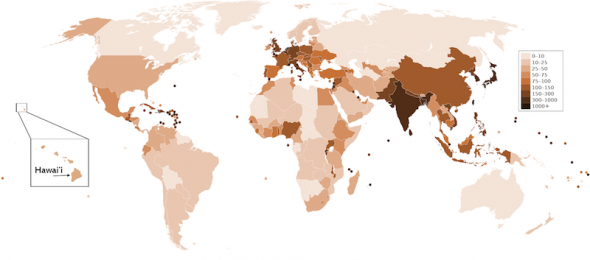Title
Compare-Contrast-Connect: Human Density
NGSS Science and Engineering Practices
Human population density maps, such as the one in SF Fig. 2.1.1, are maps showing the number of people in an area. In 2011 there were approximately seven billion people in the world. EarthвҖҷs total land area is approximately 150 million square kilometers (km2).
Image caption
SF Fig. 2.1.1. A world map showing human population density in 2011. Darker colors indicate countries with a higher population density. Numbers on the legend indicate number of people per square kilometer (km2). All countries smaller than 20,000 km2 are represented by a dot.
Image copyright and source
If every human on the planet in 2011 were placed into one area, people would take up a relatively small amount of space. For example, if everyone were given 0.9 square meters (m2), which is about the area of made by one arm span, the entire worldвҖҷs population would take up 6,300 km2 of space. So, with only room enough for each person to spin around with their arms extended, the entire human population could mathematically fit in an area the size of the largest island in the Hawaiian island chain, the Island of HawaiвҖҳi (10,430 km2)!
When a number of people is placed in a smaller area, human density is increased. Density can also increase by adding more people to a given area. In other words, when the total human population increases, human density on the planet also increases because the amount of space available for humans to live on earth is relatively constant.
Question Set
- What was the average human population density in 2011? (Hint: divide the number of people on earth in 2011 by the total land area of earth.)
- What would the average human population density be if all of the people on earth in 2011 were placed on the island of HawaiвҖҳi? (Hint: divide the number of people on earth in 2011 by the land area of the island of HawaiвҖҳi.)
- Knowing earthвҖҷs average human density is not very useful because people are not spread evenly over the worldвҖҷs landmasses. Looking at SF Fig. 2.1.1, what patterns can you detect in human density in terms of geographical areas?
- Where do lots of people live? Why do you think people live there?
- Where do only a few people live? Why do you think few people live there?
- The United Nations projects the human population could increase to 10.5 billion by 2050. If this projection is correct, what would the average population density be in 2050?
- How are human density and the density of matter similar? How are they different?








